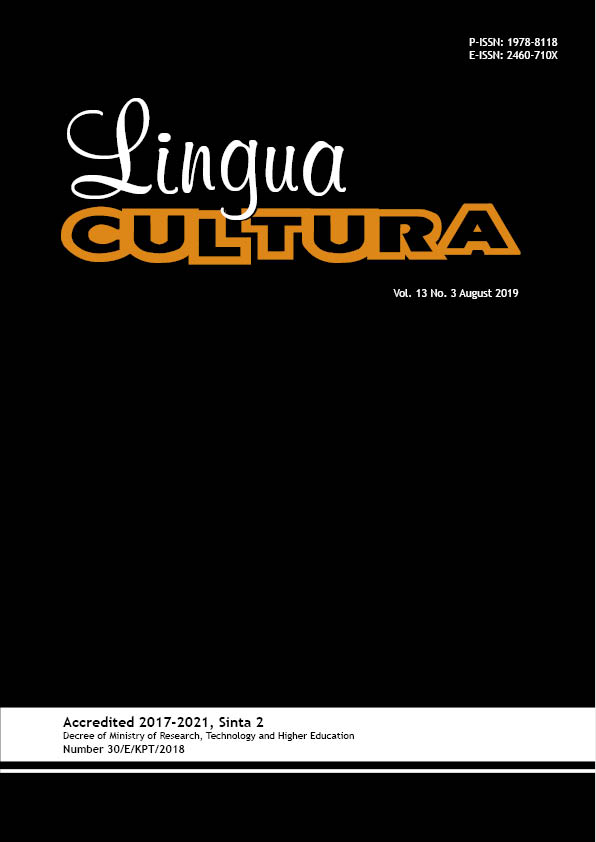Metaphor Analysis on Color Lexicon with Plant Attributes in Madurese Language
DOI:
https://doi.org/10.21512/lc.v13i3.5769Keywords:
metaphor analysis, color lexicon, plant attributes, Madurese languageAbstract
The research aimed to describe the Madurese color lexicons with plant attributes and to analyze those lexicons metaphorically. This research engaged 18 informants to denote Madurese color lexicons by showing 139 color cards. The referential comparison method was followed by sorting the decisive element technique through referential competence-in-dividing, and Connect Compare Equate as the advanced technique was used as the data analysis method. The research finds that 53 color lexicons with plant attributes in 8 Madurese color lexicons, namely potÑ â€˜white’, celleng ‘black’, mÑra ‘red’, bhiru ‘green’, konÑng ‘yellow’, cokklat ‘brown’, bhiru ‘blue’, and bungo ‘purple’. Furthermore, these plant attributes can be classified into fruits, flowers, vegetables, seeds, spices, leaves, trees, part of the tree, and part of the fruit. The domination of plant attributes in Madurese color lexicons emerges due to the sociocultural factors embodied in Madurese ethnic group itself, those are (1) farming is Madurese main way of living, (2) Madurese ethnic group respect the nature as the place where they can pray and thank God, and (3) some objects associated with color lexicons are abundantly available at their surroundings, thus they frequently use it in their daily life.
References
Azhar, I. N. (2017). Prinsip-prinsip hidup masyarakat Madura seperti terkisah dalam cerita rakyatnya. Atavisme, 20(2), 224–236. https://doi.org/10.24257/atavisme.v20i2.372.224-236.
Davies, W. (2010). A grammar of Madurese. New York: De Gruyter Mouton.
Devianty, R. (2017). Bahasa sebagai cermin kebudayaan. Jurnal Tarbiyah, 24(2), 226–245. doi: http://dx.doi.org/10.30829/tar.v24i2.167.
Dewi, F., Widayati, W., & Sucipto, S. (2017). Kajian dialektologi bahasa Madura dialek Bangkalan. Fonema, 4(2), 60–77. https://doi.org/10.25139/fonema.v4i2.759.
Diputra, G. D. R. (2017). Konotasi warna pada masyarakat Bali. Linguistika, 24(47), 142–149.
Idrus. (2015). Metafora deskripsi fisik tokoh wanita dalam novel. Jurnal Puitika, 11(1), 74–81.
Indra, Y. (2017). Analisis semantik metafora warna bahasa Minangkabau. Metalingua, 15(1), 117–128. doi: http://dx.doi.org/10.26499/metalingua.v15i1.159.
Kuswarini, P., Masdiana., & Hantik, Z. (2018). Penerjemahan metafora dalam Saman ke dalam bahasa Prancis. Jurnal Ilmu Budaya, 6(1), 177–185.
Putri, N. A., (2017). Metafora pengungkap kecantikan dalam masyarakat Madura. Etnolingual, 1(2), 73-99. http://dx.doi.org/10.20473/etno.v1i2.7395.
Raihany, A. (2015). Pergeseran penggunaan bahasa Madura di kalangan anak-anak Sekolah Dasar Negeri di desa Pangarangan kecamatan kota Sumenep. Nuansa, 12(1), 47–74. doi: http://dx.doi.org/10.19105/nuansa.v12i1.697.
Sekarsari, W., & Haristiani, N. (2016). Analisis makna “Kanyoku†yang berkaitan dengan warna: Kajian linguistik kognitif. Jurnal Pendidikan Bahasa Dan Sastra, 16(1), 96–109. https://doi.org/10.17509/bs_jpbsp.v16i1.3066.
Wijana, I. D. P. (2015). Metaphor of colors in Indonesian. Humaniora, 27(1), 3–13. https://doi.org/10.22146/jh.v27i1.6397.
Downloads
Published
How to Cite
Issue
Section
License
Authors who publish with this journal agree to the following terms:
a. Authors retain copyright and grant the journal right of first publication with the work simultaneously licensed under a Creative Commons Attribution License - Share Alike that allows others to share the work with an acknowledgment of the work's authorship and initial publication in this journal.
b. Authors are able to enter into separate, additional contractual arrangements for the non-exclusive distribution of the journal's published version of the work (e.g., post it to an institutional repository or publish it in a book), with an acknowledgment of its initial publication in this journal.
c. Authors are permitted and encouraged to post their work online (e.g., in institutional repositories or on their website) prior to and during the submission process, as it can lead to productive exchanges, as well as earlier and greater citation of published work.
USER RIGHTS
All articles published Open Access will be immediately and permanently free for everyone to read and download. We are continuously working with our author communities to select the best choice of license options, currently being defined for this journal as follows: Creative Commons Attribution-Share Alike (CC BY-SA)


















